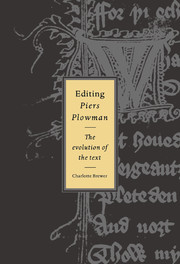Book contents
- Frontmatter
- Contents
- Acknowledgements
- Abbreviations
- Note on the texts
- Introduction
- Part I The early phase
- Part II The late nineteenth century
- Part III The Skeat aftermath
- Part IV Chambers and Grattan, Knott and Fowler
- 12 Chambers 1909–1910
- 13 Chambers versus Knott
- 14 Chambers' graduate students
- 15 Chambers 1931
- 16 Chambers 1935–1942
- 17 The Chambers and Grattan collations
- 18 Grattan and Kane
- 19 Knott and Fowler, Donaldson, Mitchell, and Russell
- Part V The Athlone Press edition
- Part VI Epilogue: the Athlone aftermath: Schmidt, Pearsall, Rigg-Brewer, et al.
- Works cited
- General index
- Index of manuscripts
- CAMBRIDGE STUDIES IN MEDIEVAL LITERATURE
12 - Chambers 1909–1910
Published online by Cambridge University Press: 20 August 2009
- Frontmatter
- Contents
- Acknowledgements
- Abbreviations
- Note on the texts
- Introduction
- Part I The early phase
- Part II The late nineteenth century
- Part III The Skeat aftermath
- Part IV Chambers and Grattan, Knott and Fowler
- 12 Chambers 1909–1910
- 13 Chambers versus Knott
- 14 Chambers' graduate students
- 15 Chambers 1931
- 16 Chambers 1935–1942
- 17 The Chambers and Grattan collations
- 18 Grattan and Kane
- 19 Knott and Fowler, Donaldson, Mitchell, and Russell
- Part V The Athlone Press edition
- Part VI Epilogue: the Athlone aftermath: Schmidt, Pearsall, Rigg-Brewer, et al.
- Works cited
- General index
- Index of manuscripts
- CAMBRIDGE STUDIES IN MEDIEVAL LITERATURE
Summary
A considerable stash of letters and papers belonging to R. W. Chambers now survives in the library of University College, London. Chambers made very few copies of his outgoing letters, but–fortunately for us–kept a number of the interesting and important communications that he received from scholars such as Henry Bradley, Skeat, and Furnivall. These give a valuable insight into the contemporary reception of Chambers' work on the poem, particularly his first article. Chambers also kept some of his notes on Piers Plowman manuscripts, along with copies of his correspondence with Grattan and with various librarians. Piecing these all together is a difficult, one-sided, and ultimately speculative task, but it does give us some idea, albeit sketchy, of the manner in which his textual work on the poem progressed.
The surprising indication of some of the material is that Chambers' and Grattan's consultation of the manuscripts themselves, as opposed to their reading and digestion of Skeat's editions and Manly's articles, may have begun as late as January 1909. A letter dated 7 January 1909 from W. W. Greg, librarian of Trinity College Cambridge, grants Grattan permission to see a Trinity manuscript, apparently for the first time. This was presumably the Trinity A-MS (R. 3. 14), which Chambers and Grattan's 1909 article, discussed in chapter 10 above, pinpoints as one of the most important of the A-MSS, and a major, indeed superior, rival to Skeat's Vernon. The letter indicates that much of the first-hand work for the article must have occurred after this date, and possibly in as little as three months.
- Type
- Chapter
- Information
- Editing Piers PlowmanThe Evolution of the Text, pp. 219 - 236Publisher: Cambridge University PressPrint publication year: 1996

